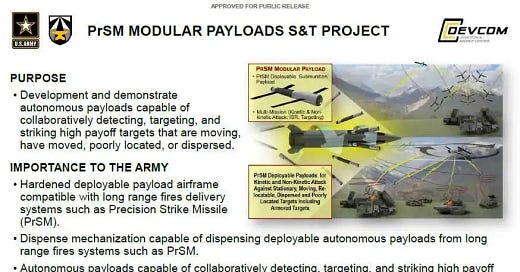Will Loitering Munitions Dominate Land Warfare?
Are FPV drones just one fleeting means of providing that capability?
The small FPV suicide drone is the belle of the battlefield ball now. Enthusiasts believe it will dominate future battlefields and we’d best hop on board the train before it leaves the station. I believe counter-measures will blunt this new weapon, making them less effective, cheap, and numerous than they are now. I also believe that other weapons will be able to rival the small FPV suicide drone and provide the same capabilities without some of the drawbacks.
Will this modular payload capability for a missile challenge the small FPV suicide drone?
Future versions of the Precision Strike Missile (PrSM) short-range ballistic missile for the U.S. Army could carry Coyote drones or Hatchet miniature glide bombs, according to Lockheed Martin. The Army has previously talked about potentially loading PrSMs with swarming munitions and other “enhanced” payloads, but without providing more specific details.
PrSM already has planned increments, with the second being the ability to strike moving land and naval targets; and four and five extending the missile’s range substantially. Oddly, increment four is now after the third increment:
Increment 3, which the Army now envisions as coming after Increment 4, is about “enhanced lethality.”
For Increment 3, the Army “will put a different warhead in there,” Lockheed Martin’s Withrow explained. “They have yet to decide. It’s still in the S&T [science and technology] community. So they’re looking at various warhead options.”
“I know they’ve looked at things like Coyote, they’ve looked at Hatchet, things like that,” Withrow added, stressing that she was not aware of any final decision having been made.
First-person viewer (FPV) suicide drones are taking the battlefield by storm. I suspect we are over-stating their value by freezing a moment in time when they are most effective. Not everybody can be a FPV drone operator.
Their reduced role in the future will be pushed along not just be defensive measures, but by new offensive means that do what the FPV drones can do but perhaps without some of the weaknesses. I explored that issue in regard to new missiles carrying a wide range of sub-munitions:
Should the Army really jump on the bandwagon of small, cheap suicide FPV drones when it has CBU-97-type weapons?
Really, this development follows the path of anti-tank guided missiles if you think of FPV drones as modern Sagger ATGMs. CBU-97s are just suicide drones carried to the battlefield in a dispenser shell, but with no loiter time. It's a First-Robot View suicide drone, no?
Will it make sense to rely on manpower-intensive drone units that launch short-range FPV loitering munitions all along the front? Or will it make more sense to mostly use missiles from ground, air, and sea launchers as well as air-dropped glide bombs? High-altitude balloons could be a launch platform, too.
These means of launching loitering munitions will provide the range to concentrate the loitering munitions and reach deep behind the lines, evading frontline short-range counter-measures.
NOTE: The image is from the initial article.




